Scientists have found a nearby planet that appears to be teeming with life, and now Earth’s most advanced computer programs revealed what it could look like.
The planet, known by astronomers as K2-18b, is located approximately 124 light-years from Earth in the constellation of Leo. One light year equals 5.88 trillion miles.
Researchers described K2-18b as a ‘hycean’ world, meaning it’s potentially one planet-sized ocean sitting beneath a hydrogen-rich atmosphere.
NASA‘s James Webb Space Telescope (JWST) investigated the planet, finding strong evidence of dimethyl sulfide (DMS) and dimethyl disulfide (DMDS), two substances that are produced by microscopic marine algae called phytoplankton here on Earth.
DailyMail.com took these findings to several of the most popular artificial intelligence (AI) chat programs, hoping that the vast sum of human knowledge in these computers could create an image of what these creatures might look like.
The image generators of ChatGPT, Grok, and DALL-E 3 didn’t disappoint, taking the atmospheric conditions of the exoplanet and producing their best possible guesses of how life would evolve on K2-18b.
The images AI predicted ranged from tiny swarms of jellyfish to frog-like creatures with eyes and limbs for walking.
Moreover, the image generators even predicted what these creatures might grow into after a few billion years of evolution.
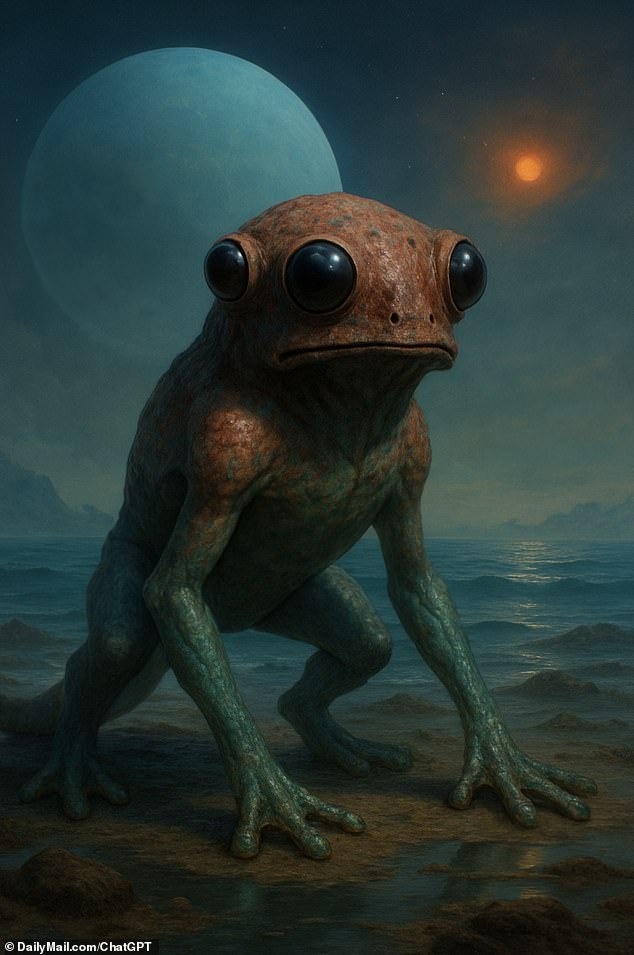
ChatGPT predicted that the lifeforms on K2-18b may evolve into large frog-like creatures with enormous eyes because of the planet’s dim sun (AI impression)
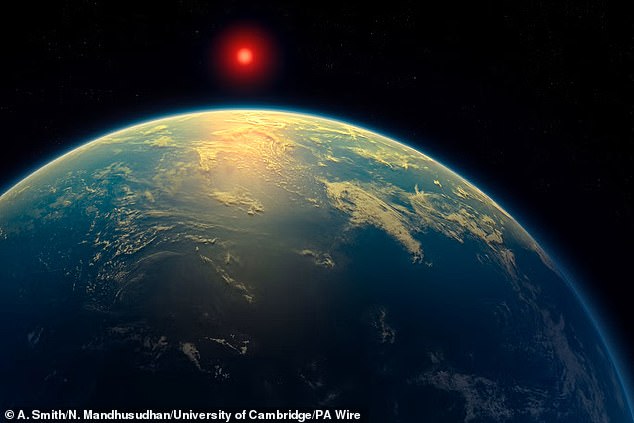
Researchers found traces of chemicals produced by life in the atmosphere of K2-18b (artist’s impression), a planet 124 light-years from Earth. This planet is most likely a ‘Hycean’ world covered by oceans
ChatGPT’s image generating software produced an extremely complex lifeform, strongly resembling a frog, but with the ability to stand up on its hind legs.
The creature, posing on a small piece of land on this giant ocean world, also had multiple pairs of eyes and similar nostrils as frogs on Earth.
AI also noted that since the light from the red dwarf star is so dim, any creatures in K2-18b’s oceans would have grown very large eyes.
A red dwarf star is a small, cool, and long-living star that burns slowly.
On K2-18b, a team from the University of Cambridge identified staggering amounts of DMS and DMDS, thousands of times greater than what’s present on Earth.
That means there could be significantly more life actively developing in the waters of this distant planet than is on Earth.
Dr Arik Kershenbaum, a Cambridge zoologist, said: ‘It’s a complex chemical that decays really quickly. So, if you see it there, then something must be making it.’
For something as complex as the creature ChatGPT theorized could exist on K2-18b, the scientists believe it could take between 1.5 and two billion years to develop.
K2-18b is 2.6 times larger and 8.6 times more massive than Earth, meaning the ocean that’s potentially covering this world would be enormous and possibly full of marine life.
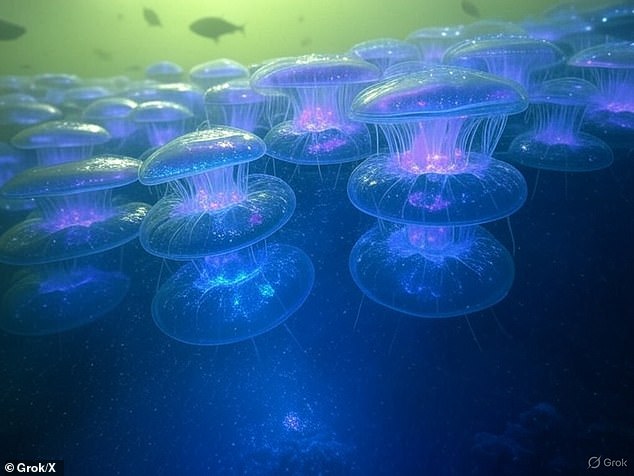
xAI’s Grok took the information from researchers at the University of Cambridge and interpreted it to mean K2-18b is home to a species of jellyfish
Based on the planet’s age, estimated to be between 2.4 and three billion years-old, the hycean world likely formed at least 1.5 billion years ago.
However, those aren’t the only lifeforms AI hypothesized may be living on K2-18b, as Grok went through the planet’s entire evolutionary history.
Grok is the advanced chatbot created by Elon Musk’s xAI. Starting with the findings of the study in The Astrophysical Journal Letters, DailyMail.com asked the advanced chatbot to consider every aspect that would go into creating life on this world.
‘Based on the data, I propose an image depicting a bioluminescent, plankton-like alien organism thriving in the upper layers of K2-18b’s global ocean, just beneath the hydrogen-rich atmosphere,’ Grok said after receiving the prompt.
‘The scene would be set in a dimly lit, deep-blue aquatic environment, with a hazy, greenish-yellow sky visible through the water’s surface, reflecting the hydrogen-rich atmosphere and possible cloud layers,’ the chatbot added.
Based on Grok’s analysis, the AI program concluded that early complex lifeforms on this planet would likely resemble swarms of jellyfish, which would be both semi-transparent and glow under water.
‘The ocean is rich with particulate matter and faint currents, indicating a dynamic, nutrient-rich ecosystem,’ Grok explained.
‘Bubbles of hydrogen gas rise from below, and the water has a slight yellowish tint due to dissolved sulfur compounds. In the background, faint silhouettes of larger, shadowy aquatic creatures hint at a diverse ecosystem.’
Alien jellyfish weren’t the only creatures Grok created, as the chatbot revealed what these organisms would likely evolve into billions of years later.
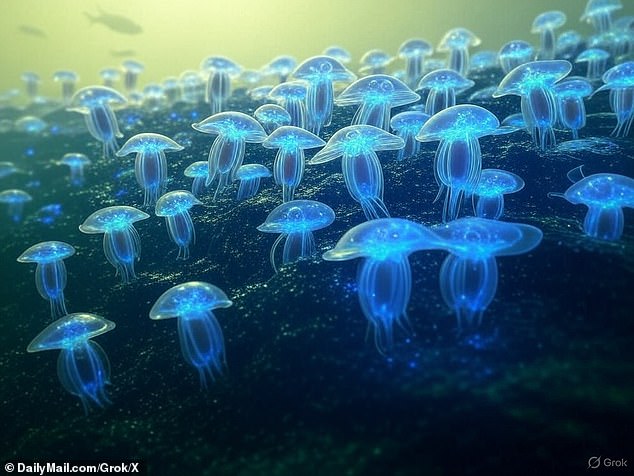
Grok added that these lifeforms would likely be bioluminescent, meaning they would glow under water like some animals on Earth

After billions of years of evolution, Grok then predicted that these creatures would grow into large marine animals that were a fusion between a dolphin and octopus
Inspired by Earth’s fish and octopuses, Grok predicted that a billion years of evolution would likely create a marine animal that had adapted several times in K2-18b’s ocean environment.
The AI program explained that the evolved creature would be between 10 and 13 feet long and shares traits with both dolphins and octopuses.
After billions of years, the AI still predicted that the creature would retain its bioluminescent skin, but would now have ‘hints of bipedal intelligence.’
Dr Kershenbaum, author of The Zoologists Guide to the Galaxy, added that life on K2-18b would be quite different to life on Earth today.
‘Even if there is an ocean on this planet it’s going to look more like what Earth looked like three or four billion years ago when life first evolved,’ he said.

The AI chatbot projected the animals to be between 10 and 13 feet long and potentially possess some level of intelligence
‘So, one thing we can say pretty confidently is that the vast majority of planets that have any sort of life on them are going to have simple life on them.’
Astronomers said this discovery is the ‘strongest hint yet’ of biological life outside our solar system, with experts hailing the Webb Telescope’s find as a ‘huge, transformational moment.’
The planet is orbiting a red dwarf star in what is known as the ‘habitable zone’ – considered the most promising location to find life-supporting planets because they orbit close enough to their sun for liquid water to exist.
DALL-E 3, OpenAI’s text-to-image model, agreed with xAI’s Grok, focusing on a world that could be home to an alien species of jellyfish.
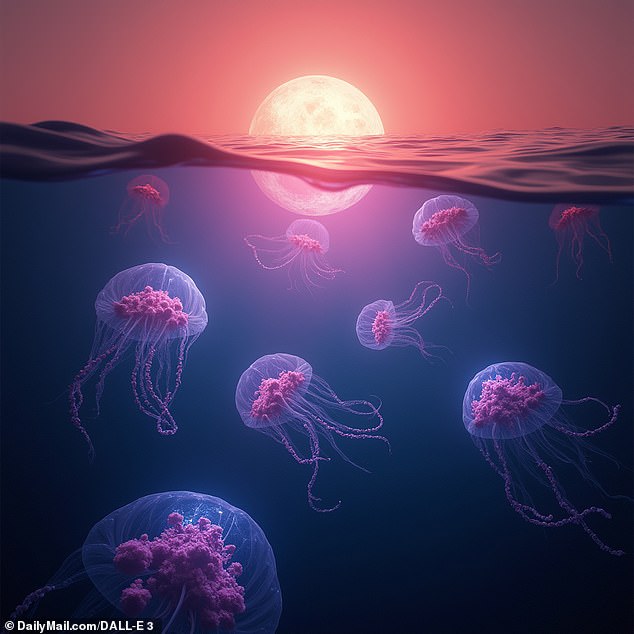
Text-to-image model DALL-E 3 also determined that the recent study of K2-18b supports the existence of a jellyfish-like creature in the planet’s oceans

K2-18b is approximately twice the size of Earth and is showing signs that it has thousands of times more phytoplankton in its water – a sign of organic life
Even when prompted to theorize what these creatures would look like after billions of years of evolution on K2-18b, the AI program’s best guess was a more complex version of the jellyfish, with a more developed body and shorter tendrils.
Astronomer Michael Garrett, a professor at Manchester University, previously told DailyMail.com: ‘I think the way complex life might appear will depend a lot on the environment within which it evolves.
‘If your star is a red giant, you might find life with eyes that are much more sensitive and larger than ours,’ he added.







